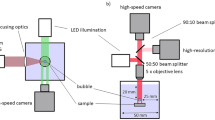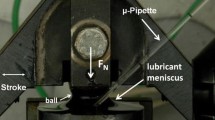Abstract
SMOOTH spherical particles have been observed during the microscopic analysis of wear surfaces (ref. 1 and R. S. Miller, personal communication) and of wear particles2 using a new technique called ferrogram developed by Westcott2. These investigators speculated that the spherical particles were produced by cavitation bubbles occurring at the contact surfaces of the bearing. The possibility of cavitation in bearings is well known3; however, it was difficult to understand how these bubbles could produce such perfect microspheres (in the range of 1 to 10 µm in diameter). To verify that cavitation erosion could indeed produce such spheres, we conducted careful experiments with the help of the American Society for Testing and Materials (ASTM) standard vibratory cavitation erosion apparatus; this communication reports the results of this investigation.
Similar content being viewed by others
References
Scott, D., and Mills, G. H., Wear, 16, 234–237 (1970).
Westcott, V. C., Survey of Wear Processes and the Particles Resulting from Wear by means of a Ferrograph, (Trans-Sonics Incorporated Technical Report to Office of Naval Research dated, October 1972).
Thiruvengadam, A., Appl. Mech. Revs, 245–253 (March 1971).
Author information
Authors and Affiliations
Rights and permissions
About this article
Cite this article
DOROFF, S., MILLER, R., THIRUVENGADAM, A. et al. Spheroidal particles produced by cavitation erosion. Nature 247, 363–364 (1974). https://doi.org/10.1038/247363a0
Received:
Issue Date:
DOI: https://doi.org/10.1038/247363a0
- Springer Nature Limited
This article is cited by
-
Cavitation–silt erosion in sand suspensions
Journal of Mechanical Science and Technology (2018)





